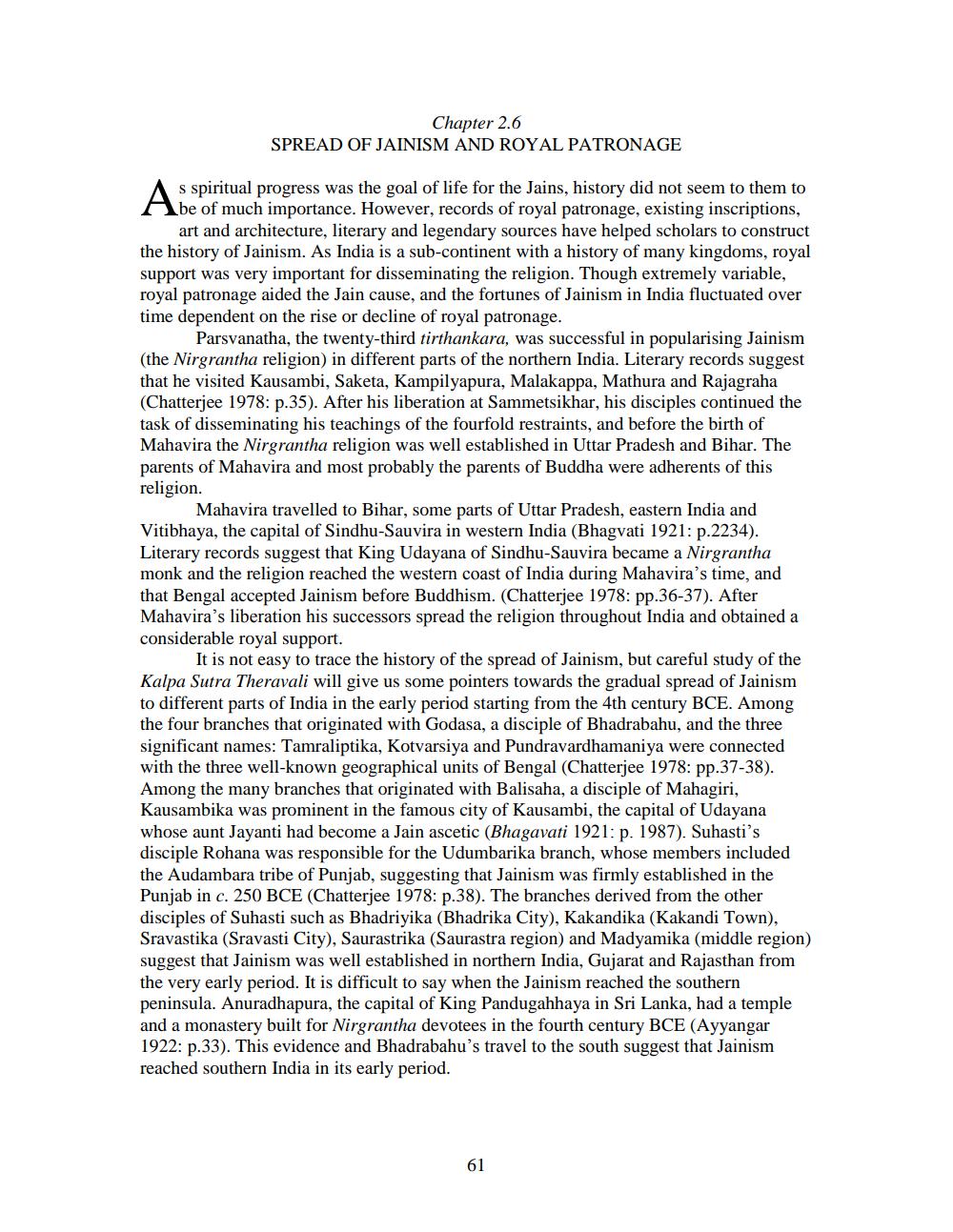________________
Chapter 2.6 SPREAD OF JAINISM AND ROYAL PATRONAGE
s spiritual progress was the goal of life for the Jains, history did not seem to them to be of much importance. However, records of royal patronage, existing inscriptions,
art and architecture, literary and legendary sources have helped scholars to construct the history of Jainism. As India is a sub-continent with a history of many kingdoms, royal support was very important for disseminating the religion. Though extremely variable, royal patronage aided the Jain cause, and the fortunes of Jainism in India fluctuated over time dependent on the rise or decline of royal patronage.
Parsvanatha, the twenty-third tirthankara, was successful in popularising Jainism (the Nirgrantha religion) in different parts of the northern India. Literary records suggest that he visited Kausambi, Saketa, Kampilyapura, Malakappa, Mathura and Rajagraha (Chatterjee 1978: p.35). After his liberation at Sammetsikhar, his disciples continued the task of disseminating his teachings of the fourfold restraints, and before the birth of Mahavira the Nirgrantha religion was well established in Uttar Pradesh and Bihar. The parents of Mahavira and most probably the parents of Buddha were adherents of this religion.
Mahavira travelled to Bihar, some parts of Uttar Pradesh, eastern India and Vitibhaya, the capital of Sindhu-Sauvira in western India (Bhagvati 1921: p.2234). Literary records suggest that King Udayana of Sindhu-Sauvira became a Nirgrantha monk and the religion reached the western coast of India during Mahavira's time, and that Bengal accepted Jainism before Buddhism. (Chatterjee 1978: pp.36-37). After Mahavira's liberation his successors spread the religion throughout India and obtained a considerable royal support.
It is not easy to trace the history of the spread of Jainism, but careful study of the Kalpa Sutra Theravali will give us some pointers towards the gradual spread of Jainism to different parts of India in the early period starting from the 4th century BCE. Among the four branches that originated with Godasa, a disciple of Bhadrabahu, and the three significant names: Tamraliptika, Kotvarsiya and Pundravardhamaniya were connected with the three well-known geographical units of Bengal (Chatterjee 1978: pp.37-38). Among the many branches that originated with Balisaha, a disciple of Mahagiri, Kausambika was prominent in the famous city of Kausambi, the capital of Udayana whose aunt Jayanti had become a Jain ascetic (Bhagavati 1921: p. 1987). Suhasti's disciple Rohana was responsible for the Udumbarika branch, whose members included the Audambara tribe of Punjab, suggesting that Jainism was firmly established in the Punjab in c. 250 BCE (Chatterjee 1978: p.38). The branches derived from the other disciples of Suhasti such as Bhadriyika (Bhadrika City), Kakandika (Kakandi Town). Sravastika (Sravasti City), Saurastrika (Saurastra region) and Madyamika (middle region) suggest that Jainism was well established in northern India, Gujarat and Rajasthan from the very early period. It is difficult to say when the Jainism reached the southern peninsula. Anuradhapura, the capital of King Pandugahhaya in Sri Lanka, had a temple and a monastery built for Nirgrantha devotees in the fourth century BCE (Ayyangar 1922: p.33). This evidence and Bhadrabahu's travel to the south suggest that Jainism reached southern India in its early period.




